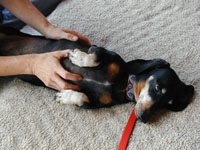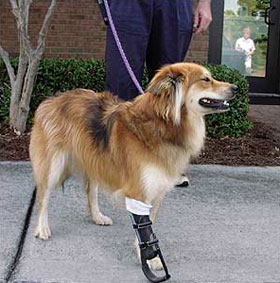A big thank you to Kim Bauer of Tallgrass Animal Acupressure Institute for permission to reprint this article.
We have so many more advances in caring for our pets these day than we have ever had. Sharing this information will hopefully help to educate many others that there are choices.
Article written by Kim Kizzier, South Dakota, Tallgrass Equine & Canine Acupressure Practitioner, Tallgrass Animal Acupressure Institute
Spinal Compression in Dachshunds
By Kim Kizzier, Certified Tallgrass Equine & Canine Acupressure Practitioner
 I have had the opportunity to work with 2 different dachshunds (Sadie & Salty Dog) that suffered spinal compressions and paralysis. Both were given poor prognosis without surgery and euthanasia was the most likely recommended alternative. Sadie suffered calcified disc and dorsal herniation at L3 & L4 and was sent home with steroid treatment and pain medication. Salty was evaluated by both his regular veterinarian and an ACVS surgeon. He did not have radiographs but the suspected problem was in the thoracic region and he was sent home with a week’s worth of pain medication. Neither owner was able to afford the surgical option.
I have had the opportunity to work with 2 different dachshunds (Sadie & Salty Dog) that suffered spinal compressions and paralysis. Both were given poor prognosis without surgery and euthanasia was the most likely recommended alternative. Sadie suffered calcified disc and dorsal herniation at L3 & L4 and was sent home with steroid treatment and pain medication. Salty was evaluated by both his regular veterinarian and an ACVS surgeon. He did not have radiographs but the suspected problem was in the thoracic region and he was sent home with a week’s worth of pain medication. Neither owner was able to afford the surgical option.
I began work with Sadie hours after she presented to her veterinarian. She was in a lot of pain and had no use of her hind legs or tail. I worked very gently the first couple days but was able to work deeper and with more intensity in later treatments as Sadie began to gain strength. I showed the owner how to continue work between treatments. Sadie was trying to stand on the 5th day, walking a few days later and is back to her usual self now.
I began working with Salty a few days after his initial incident. He was painful and had many muscle spasms in his back. He had no feeling in his hind legs or tail and had a hard time holding his bladder. Again, I showed the owner how to work points and massage between my treatments every few days. Salty’s owner, Lisa, was getting married and moving in a month, so we were pressed for time. By the time they moved, Salty was beginning to stand and could walk a few steps. I received video of him trotting around about 10 days later. He continues to improve and is a happy little dog.
I had just returned from the Tallgrass Continuing Education class “Tui Na” when I first met Sadie. I used acupoints, theories, and techniques learned from Amy Snow, Nancy Zidonis and Dr. Shauna Cantwell.
I immediately addressed the Chi stagnation presenting as pain and paralysis within the spinal column and governing vessel. I adjusted the duration and intensity of treatment according to the patient’s level of fragility.
 Vibration (Zhen-fa & Dou-fa) or massage on KI 1, Tip of tail, GV14, GB20, very gently on the injured area and spasming muscles, and down the spinal column from neck to tip of tail.
Vibration (Zhen-fa & Dou-fa) or massage on KI 1, Tip of tail, GV14, GB20, very gently on the injured area and spasming muscles, and down the spinal column from neck to tip of tail. - Stimulation (holding, vibration, photonic light, or massage) on:
- ST36, LI4, LIV3, LI11, and injured area
- Massage of neck, shoulders, and chest area and governing vessel as tolerated with attempt to loosen neck and dura (covering over spinal column).
- Skin rolling (Nie-fa) from head to tail and from hip to foot.
- Passive movement of hind legs and tail as tolerated.
- Gentle movement and twisting of toes on hind legs (Nian-fa).
- Holding to send energy and use of Reiki over both Governing and Conception Vessel (especially injured area).


